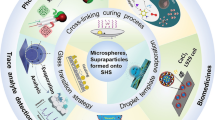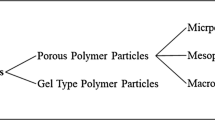Abstract
An amphoteric initiator of 2,2′-azobis[N-(2-carboxyethyl)-2-2-methylpropionamidine] (VA-057) was applied to fabrication of raspberry-shaped composite particles in soap-free emulsion polymerization of styrene in the presence of silica particles surface-modified with 3-methacryoxypropyltrimethoxysilane. In the polymerizations, pH of the solution was ranged from 7.9 to 9.9 to alter dissociation degree of ionizable groups in the initiator. Raspberry-shaped particles were obtained in a pH range of 8.0 to 9.3 followed by a tendency in which average size of polystyrene (PSt) nodules adsorbed onto the silica particles decreased with pH. This tendency was similar to that of polymer particles formed in conventional soap-free emulsion polymerization in the absence of the silica particles. An increase in silica particle concentration led to a decrease in the final size in PSt nodules. The decrease was caused by the stabilization of polymer particles fixed to the silica surface against polymer particle aggregation in water phase.





Similar content being viewed by others
References
Cheng X, Chen M, Zhou S, Wu L (2006) Preparation of SiO2/PMMA composite particles via conventional emulsion polymerization. J Polym Sci A 44:3807–3816. doi:10.1002/pola.21472
Zhang H, Su Z, Liu P, Zhang F (2007) Preparation and property of raspberry-Like AS/SiO2 nanocomposite particles. J Appl Polym Sci 104:415–421. doi:10.1002/app. 25172
Zeng Z, Yu J, Guo Z (2005) Preparation of polymer/silica composite nanoparticles bearing carboxyl groups on the surface via emulsifier-free emulsion copolymerization. J Polym Sci A 43:2826–2835. doi:10.1002/pola.20764
Zhang S, Zhou S, Weng Y, Wu L (2005) Synthesis of SiO2/polystyrene nanocomposite particles via miniemulsion polymerization. Langmuir 21:2124–2128. doi:10.1021/la047652b
Wu Q, Wang Z, Kong X, Gu X, Xue G (2008) A ficile strategy for controlling the self-assembly of nanocomposite particles based on colloidal steric stabilization theory. Langmuir 24:7778–7784. doi:10.1021/la800532q
Reculusa S, Poncet-Legrand C, Perro A, Duguet E, Bourgeat-Lami E, Mingotaud C, Ravaine S (2005) Hybrid dissymmetrical colloidal particles. Chem Mater 17:3338–3844. doi:10.1021/cm050406g
Nagao D, Hashimoto M, Hayasaka K, Konno M (2008) Synthesis of anisotropic polymer particles with soap-free emulsion polymerization in the presence of a reactive silane coupling agent. Macromol Rapid Commun 29:1484–1488. doi:10.1002/marc.200800279
Perro A, Reculusa S, Bourgeat-Lami E, Duguet E, Ravaine S (2006) Synthesis of hybrid colloidal particles: from snowman-like to raspberry-like morphologies. Colloids Surf A 284–285:78–83. doi:10.1016/j.colsurfa.2005.11.073
Guo S, Dong S, Wang E (2008) A general method for the rapid synthesis of hollow metallic or bimetallic nanoelectrocatalysts with urchin like morphology. Chem Eur J 14:4689–4695. doi:10.1002/chem.200800077
Xu Z, Xia A, Wang C, Yang W, Fu S (2007) Synthesis of raspberry-like magnetic polystyrene microspheres. Mater Chem Phys 103:494–499. doi:10.1016/j.matchemphys.2007.02.074
Luna-Xavier J, Guyot A, Bourgeat-Lami E (2004) Preparation of nano-sized silica/poly(methylmethacrylate) composite latexes by heterocoagulation: comparison of three synthetic routes. Polym Int 53:609–617. doi:10.1002/pi.1440
Reculusa S, Poncet-Legrand C, Ravaine S, Mingotaud C, Duguet E, Bourgeat-Lami E (2002) Syntheses of raspberry like silica/polystyrene materials. Chem Mater 14:2354–2359. doi:10.1021/cm0116525
Ming JW, Wu D, van Benthem R, de With G (2005) Superhydrophobic films from raspberry-like particles. Nano Lett 5:2298–2301. doi:10.1021/nl0517363
Hong J, Bae WK, Lee H, Oh S, Char K, Caruso F, Cho J (2007) Tunable superhydrophobic and optical properties of colloidal films coated with block copolymer micelles/micelle multilayers. Adv Mater 19:4364–4369. doi:10.1002/adma.200701362
Tsai H, Lee Y (2007) Facile method to fabricate raspberry-like particulate films for superhydrophobic surfaces. Langmuir 23:12687–12693. doi:10.1021/la702521u
Bourgeat-Lami E, Herrera NN, Putaux J, Reculusa S, Perro A, Ravaine S, Mingotaud C, Duguet E (2005) Surface assisted nucleation and growth of polymer latexes on organically-modified inorganic particles. Macromol Symp 229:32–46. doi:10.1002/masy.200551105
Bourgeat-Lami E, Herrera NN, Putaux J, Perro A, Reculusa S, Ravaine S, Duguet E (2007) Designing organic/inorganic colloids by heterophase polymerization. Macromol Symp 248:213–226. doi:10.1002/masy.200750223
Reculusa S, Mingotaud C, Bourgeat-Lami E, Duguet E, Ravaine S (2004) Synthesis of daisy-shaped and multipod-like silica/polystyrene nanocomposites. Nano Lett 4:1677–1682. doi:10.1021/nl049161h
Gu S, Inukai S, Konno M (2002) Preparation of monodisperse, micron-sized polystyrene particles with an amphoteric initiator in soap free polymerization. J Chem Eng Jpn 35:977–981
Gu S, Akama H, Nagao D, Kobayashi Y, Konno M (2004) Preparation of micrometer-sized poly(methyl methacrylate) particles with amphoteric initiator in aqueous media. Langmuir 20:7948–7951. doi:10.1021/la049280c
Yamada Y, Sakamoto T, Gu S, Konno M (2005) Soap-free synthesis for producing highly monodisperse, micrometer-sized polystyrene particles up to 6 μm. J Colloid Interface Sci 281:249–252. doi:10.1016/j.jcis.2004.08.030
Nagao D, Sakamoto T, Konno H, Gu S, Konno M (2006) Preparation of micrometer-sized polymer particles with control of initiator dissociation during soap-free emulsion polymerization. Langmuir 22:10958–10962. doi:10.1021/la061451l
Nagao D, Yokoyama M, Yamauchi N, Matsumoto H, Kobayashi Y, Konno M (2008) Synthesis of highly monodisperse particles composed of a magnetic core and fluorescent shell. Langmuir 24:9804–9808. doi:10.1021/la801364w
Acknowledgement
This research was partially supported by a Grant-in-Aid for Science Research (no. 20681011 and no. 20360354).
Author information
Authors and Affiliations
Corresponding author
Rights and permissions
About this article
Cite this article
Nagao, D., Ueno, T., Oda, D. et al. Size control of polystyrene nodules formed on silica particles in soap-free emulsion polymerization with amphoteric initiator. Colloid Polym Sci 287, 1051–1056 (2009). https://doi.org/10.1007/s00396-009-2063-7
Received:
Revised:
Accepted:
Published:
Issue Date:
DOI: https://doi.org/10.1007/s00396-009-2063-7




